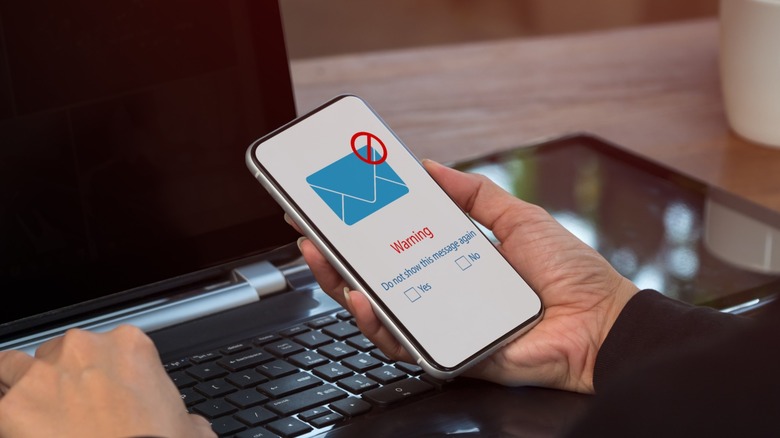What To Do When Unsubscribing From An Email List Doesn't Work
When was the last time you had an empty inbox? Probably the day you created your email address. And since you received the first confirmation or welcome mail, you've gotten tons more from every website you visit, every service you sign up for, and every newsletter you subscribe to. At first, these messages don't seem like a big deal. But over time, they start to pile up.
Before you know it, your inbox is teeming with promotional emails, discount codes, and updates you didn't ask for. They take up valuable cloud space, clutter your inbox, and—let's be honest—become a bit of a pain to look at. Beyond just being annoying, all that digital mess can distort your focus. And according to experts, a cluttered inbox can make you feel overwhelmed and less productive.
Now, to get a handle on things, you may have tried to clear out your inbox by unsubscribing from all the emails you don't need. Yet somehow, the messages just keep coming. This makes you wonder if the unsubscribe button even works at all. Unfortunately, in certain cases, it seems to lead to even more spam. But why does this happen, and what can you do to stop it?
Why do emails keep coming even after you unsubscribe?
Unsubscribe all you want, but there are some emails you cannot avoid. For instance, if you buy something from a company or use any of its services, you'll receive transactional emails like order confirmations, shipping details, receipts, or updates to terms and conditions (T&Cs). These are essential for maintaining your relationship with the company, but anything outside of this, like promotional offers, is entirely optional. You have the right to say no to those. Unfortunately, some companies choose to ignore your unsubscribe requests.
In an ideal world, clicking the unsubscribe button would signal to the business that you're no longer interested in hearing from them, and they should remove you from their email list. Legitimate companies will respect this decision and process your request. But not all marketers are noble. Some deliberately make unsubscribing a complicated, drawn-out process to keep you on their list. Others, likely spammers, see your unsubscribe request as proof that your email address is active. They may then sell your email address to other companies who continue to spam you.
Before you panic, not all situations are malicious. Sometimes, the delay is just due to the mechanics of large email systems. Bigger companies managing extensive subscriber lists often need time to process unsubscribe requests. So, you might still get emails for a little while before the removal process is finalized.
However, there's also the possibility that the company uses multiple email services. Many companies segment their mailing lists into categories like marketing, updates, or customer service, and unsubscribing from one doesn't automatically mean you're removed from the others. To stop receiving emails entirely, you'll often need to unsubscribe from each list individually. When doing that doesn't work, here's what to do.
Block sender and mark email as spam
It's easy to block an email address, and if you're dealing with a legitimate business, that's usually where the communication ends. You'll never hear from them again. However, if you're dealing with a more malicious party, blocking doesn't necessarily guarantee the emails will stop trickling into your inbox. That's largely because of a popular cyber threat called spoofing.
It's a technique that allows spammers to disguise their actual email address, often replacing it with something that appears legitimate. For example, you might see an email that claims to be from "support@trustedcompany.com," but the real address behind the display name could be some random email like "xyz123@mailserver.com." This deliberate manipulation makes it almost impossible for you to block the actual source of the spam.
Another thing that makes blocking pretty ineffective is that spammers rarely rely on just one email address. So, even if you successfully block one address, the spammer still has your email address and can send their next message from an entirely new one. Spammers constantly rotate through fake accounts (and some particularly malicious ones might hack and take over other people's legitimate accounts). So, a more effective approach is to report the email as spam or junk. This trains your email provider's filters to recognize similar unwanted messages in the future. Spam filters work by analyzing the content, patterns, and metadata of emails to identify and redirect them to your spam folder.
Create filters or rules to automatically sort or delete emails
Spam filters are your first line of defense against unsolicited emails. But these filters aren't perfect, and some emails will still slip through. Thankfully, email services allow you to add extra filters or rules in your email settings. These features automatically sort or delete emails based on specific criteria, making it easier to keep your inbox tidy. In Gmail, they're called filters; in Mail for Mac, they're referred to as rules.
To create a Gmail filter, open the email you want to filter and click the three vertical dots in the top-right corner. Select "Filter messages like this" from the pop-up menu, then fill out the form with the relevant details. After that, decide what action you want Gmail to take, such as deleting the email or moving it to a specific folder. Once you're done, click "Create Filter" to save it.
For Mail on Mac, start by clicking "Mail" in the top-left corner of your screen, then select "Settings" from the drop-down menu. In the settings window, navigate to the "Rules" tab and click "Add Rule." Specify the criteria and actions for the rule. Once you've configured the rule, click OK to save it.
Now, to be fair, some emails aren't outright spam, but they still clog your inbox. For instance, think about the weekly newsletter service you willingly signed up for but never open. Instead of letting these emails pile up and eat into your storage space, you can set up filters to send them directly to the trash or move them to a "read-later" folder if you want to review them later. It's a far more efficient way to declutter your inbox.
Report to the Federal Trade Commission (FTC)
Most people generally ignore spam. They just let it clog up their inbox. Some people are more proactive and take the time to add these rules and filters that help them redirect unsolicited emails to spam or trash. However, not many people know that they can actually report persistent spammers to the authorities. That's because businesses have a duty to ensure their marketing practices comply with anti-spam laws. This means that companies should only email you with your consent, offer a straightforward way for you to unsubscribe, and stop sending emails once you've opted out.
The Federal Trade Commission (FTC), in particular, has a "Click to Cancel" rule, which says that canceling or choosing to withdraw from a subscription service must be just as easy as it was to enroll in the first place. But when companies make it difficult and continue sending unsolicited emails, it becomes spam, and in many countries, that's illegal. In the United States, under the Controlling the Assault of Non-Solicited Pornography and Marketing Act (CAN-SPAM Act), businesses that violate email marketing practices risk being fined as much as $42,530 per email. Plus, if you can prove that the onslaught of spam has really disturbed your productivity or even exposed your computer system to cyberattacks, you have strong grounds to file a lawsuit.
Be wary of email unsubscribe services
It can be really tedious, clicking unsubscribe to every unwanted email that lands in your inbox. As a result, some companies offer to help take that stress off your hands. For a fee, you give them access to your inbox, and they'll help you unsubscribe. But the thing is, they rarely work. Some of them just hide these emails from your primary inbox. But what they really do is move them to some other subfolder where it continues to take a slice of your storage space. Leave them long enough, and you'd soon have to pay for additional storage.
When Wirecutter asked some of these companies why their services rarely work, one explained that while they do try to unsubscribe you, the links in the emails themselves are unreliable. Some of these services then follow up by creating their own filters and block lists. But that's not what you're paying for, is it? Especially considering that linking this service to your email account, gives it access to your sensitive personal information.
Privacy and transparency are the biggest reasons to be wary of email unsubscribe services and third-party apps and services in general. The free ones don't hide the fact that they collect your data and share it with advertisers and researchers. The paid ones, though, claim that while they do have access to your data and can read your emails, they don't touch your personal stuff and use proprietary algorithms to encrypt the not-so-personal data that they do collect. However, there's no way to confirm that this is indeed what they do. Plus, there's a large chance your information might get into the wrong hands, regardless of what measures they've put in place.
How can you avoid getting too many unwanted emails in the future?
Moving forward, the only thing you can do is to be careful about sharing your email address online. Spammers are extremely good at scraping addresses off the internet. So, if you've ever posted your email publicly, there's a good chance some spammer has picked it up— multiple spammers, actually. And that makes spam emails inevitable. To prevent any more spam in your inbox, just avoid posting your address online.
If you're a professional or business owner who needs to stay reachable, there's a better option than listing your email directly on your website. Consider creating a contact form on your website using a tool like Google Forms. This allows clients to reach you without exposing your email to spam.
On the flip side, when you're a customer dealing with an online business, you have to remember that they want to stay top of mind and sell you as much as they can. Of course, not all of them will exploit the access you give. But be rest assured that most would. So, think twice before signing up for that newsletter or free trial.
Read their privacy policies to confirm you're not unintentionally agreeing to share your contact details with third parties. A quick search using Command + F on a Mac or Control + F on Windows for terms like "partner companies" or "affiliates" can help you spot these clauses quickly. However, if you still need to sign up, think about creating a second email account just for that. That way, your primary email address remains relatively clutter-free. And if managing multiple accounts feels like too much, you might want to use a temporary email instead.






